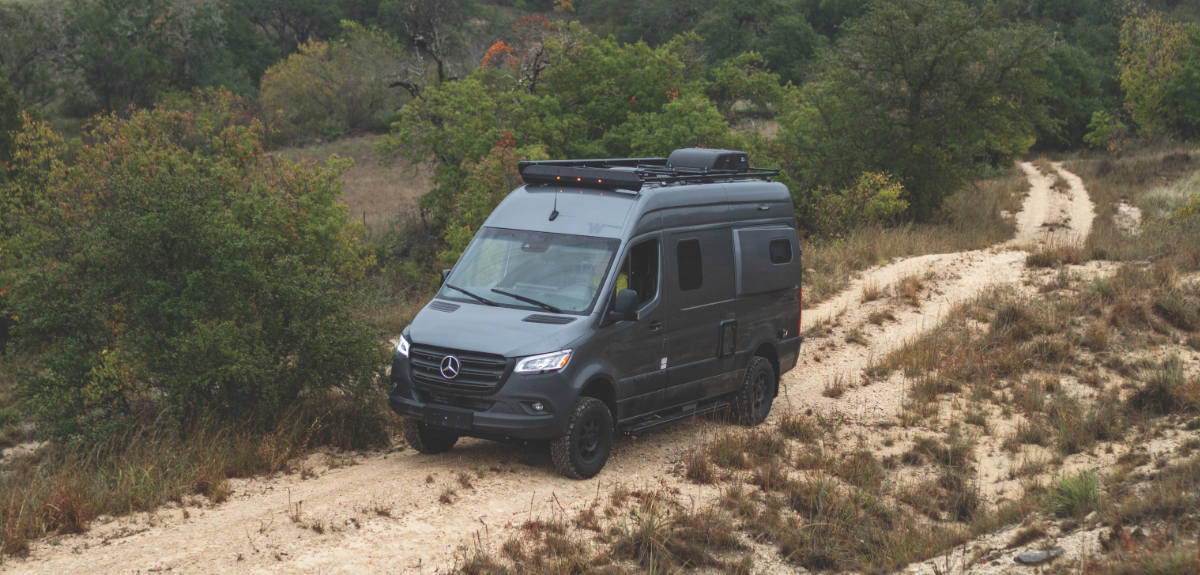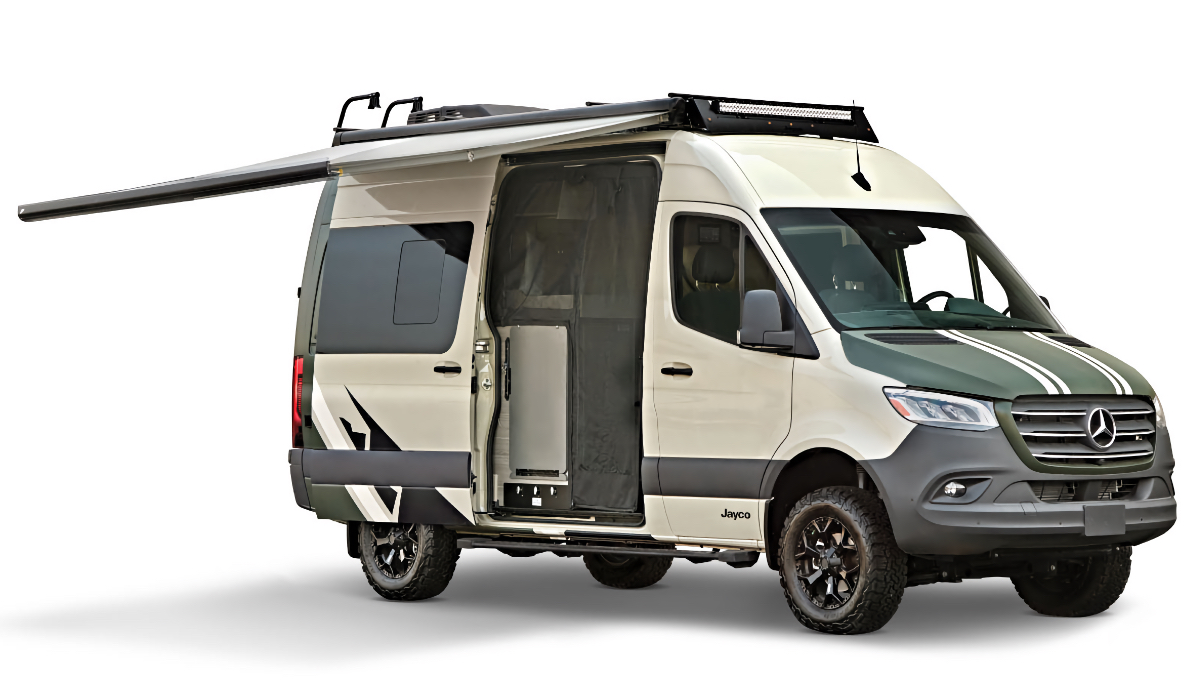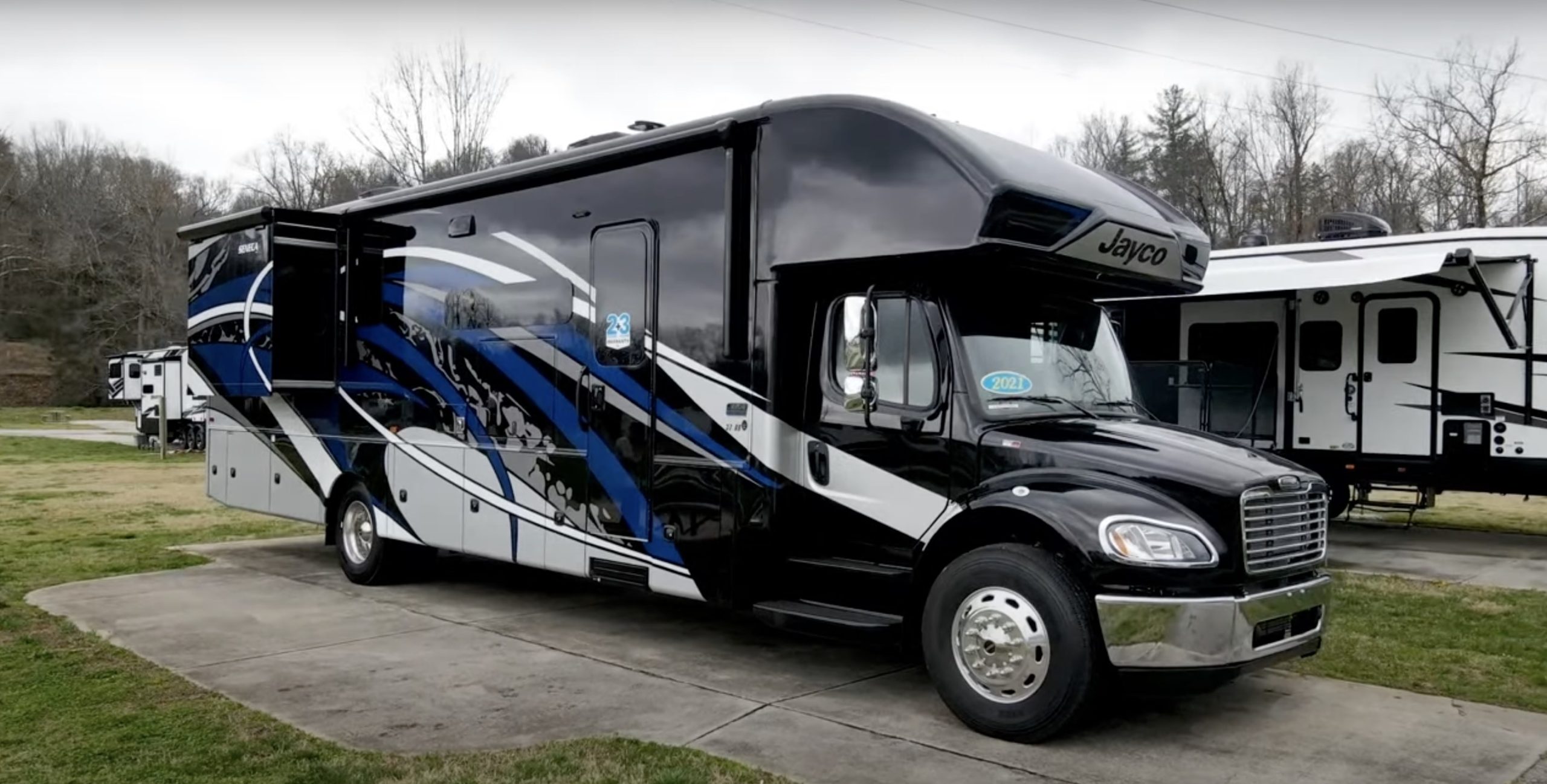Class B Review: Regency RV National Traveler
Image Caption:
The Class B motorhome market is something of an anomaly in the RV industry. That’s not a reflection on the motorhomes, mind you; as reported by Statistical Surveys Inc., a data-driven company that documents industry registrations, the Class B segment saw a sales increase of 26.5 percent for all of 2017 and is on pace for an even bigger upswing once the 2018 numbers are in.
The true picture, though, is a bit more opaque.
Looking to capitalize on a market segment that offers all the features of a motorhome at a price that, in many instances, costs about the same as a high-end luxury SUV, a number of Class B manufacturers are introducing new, sportier models aimed at new demographic groups.
Inside
Galley & Storage
Virtually every Class B motorhome built today includes bulkhead storage cabinets. With its raised roofline, the National Traveler is able to double up on them: Stacked cabinets are mounted onto the upper interior side walls on either side of the rear dinette/bed, with a third, somewhat smaller pair mounted above a shorter bench seat just aft of the driver position. Nor are these insignificant storage units. The rear cabinets, for example, stretch nearly 50 inches in length and, stacked, are 2 feet high and 10 inches deep.
In fact, storage might be one of the National Traveler’s prime selling points. In addition to the bulkhead cabinets and ample storage beneath the opposing rear benches and the forward streetside bench, the motorhome features three decently sized drawers below the abbreviated curbside galley. A microwave, deep-basin stainless-steel sink with cover, True Induction cooktop, 3.0-cubic-foot Norcold 12-volt DC/120-volt AC refrigerator and a flip-up counter for additional meal prep are among the galley hardware. Between the galley and rear dinette/sleeping area is a pullout pantry and a narrow cabinet with removable shelves that can be put to use as a small wardrobe closet. The raised roofline, by the way, also yields substantial open space above the cockpit. And, while the Traveler uses a typical fiberglass shower insert in its amidships, porcelain toilet-equipped bathroom (meaning that anyone taller than about 6 feet, 2 inches will need to tilt their head a bit), there’s yet more storage between the bath stall and ceiling.
Living Area
When set up in camp, a few more of the National Traveler’s benefits become apparent. Virtually everything in the interior that’s not countertop, flooring, appliances or wood has been covered in a padded off-white soft-touch ultraleather material. That includes the front seats, benches and backrests, interior walls and doors, the ceiling — even the back of the cabinets.
“It’s just very durable and it’s easily cleaned,” said Emahiser. A slight misadventure with a can of soda hammered home this point.
The DLX also includes a Furrion entertainment center. There’s a Bluetooth exterior speaker with LED lighting mounted high curbside along with a Firefly Integrations Multiplex system, on-demand water heater, 13,500-Btu Coleman-Mach air conditioner, exterior shower, 12-foot Carefree of Colorado lighted power awning, 2,000-watt inverter and 16,000-Btu Suburban furnace. A half-dozen 120-volt AC electrical outlets are interspersed throughout the interior.
The test motorhome also came equipped with an optional second 32-inch Samsung LED TV above the entry door, but one may very well be enough. The sightlines of the second TV aren’t the greatest, and the standard screen can be removed from its rear position near the dinette/bed and set into a mount on a lower cabinet for outside use along with a small drop-down outside table. Additionally, two removable power pads control various operations, from the awning to lights and the generator.
Special Features
The Firefly Integrations Multiplex system with Vegatouch panel allows convenient control of all the motorhome’s systems like lighting, HVAC, window shades and more via the touch pads or smart-device apps.
While few people who buy a Class B motorhome are as tall as a player for the National Basketball Association, we discovered that the raised roofline also provides other benefits. Not only does it create a larger, more airy space inside, but it also lends itself to creating a lot of additional storage, overcoming one of the biggest drawbacks to Class B ownership.
Outside
Materials & Construction
Originally designed by Dolphin Motor Coach and recently acquired by Fort Worth, Texas-based Regency RV, the National Traveler line also offers a bit more space than provided by the factory van shell, but it quite literally goes in another direction. Like a typical van conversion, the Elkhart, Indiana-built National Traveler will fit in any space you’d be comfortable parking, say, a half-ton pickup — but unlike its counterparts, the RAM ProMaster-based motorhome offers a lot more space. This is courtesy of a new roofline that maintains the aerodynamic profile of the stock RAM 3500 ProMaster, while increasing ceiling height by about a foot; head room measures up to 7 feet, 4 inches in the front of the motorhome before stepping down to a still-impressive 6 feet, 11½ inches through the rear.
“A ProMaster is a smaller vehicle to begin with,” said Don Emahiser, Regency vice president for sales and marketing. “So, we cut it at the roofline, raised it to add substantial space inside, then cleaned up the looks of what was really designed to be a commercial vehicle. We followed the lines of the vehicle but still made it look different. And along the way, we made a lot of little changes, like replacing the original commercial-sized clearance lights with smaller LED units. It’s not just about the space, it’s about the look.”
That “look,” by the way, also includes color-matching the front bumper and wheel wells and a three-dimensional graphics treatment that arches up over portions of the side windows of the top-of-the-line DLX test motorhome (National Traveler also offers the SPT and TVL models). More than vinyl add-ons, the cladding allows residents to see outside while screening prying eyes from what’s going on inside. The DLX also included optional fiberglass running boards, which didn’t so much as groan under the weight of a 300-pound passenger, as well as color-coordinated wheels.
Notable Equipment & Features
The DLX tested here was the first of its kind, and Emahiser noted that the builder plans to make a few changes in addition to dropping the second “l” in Traveller (as seen in the photos). As shown, the DLX sports a rear dinette, with the 32-by-18-inch table stowing securely in an integrated pouch on one of the rear European-style doors. Production units will have two eating locations: one to the rear and the other utilizing the front swivel seats. Another planned floorplan will incorporate a second drop-down rear bed. “You’ll sacrifice some of the storage capabilities,” said Emahiser, “but you’ll have a Class B that will sleep four adults. That’s unheard of.”
The National Traveler DLX also features two items that Dolphin pioneered on its Sprinter lines: an automotive-style wiring harness to simplify manufacturing and, if necessary, repair, and the optional NDW water-filtration system. An ozone-based water filtration and purification system that combines a 5-micron filtration system with Ozotech’s proprietary activated oxygen/ozone generator, the NDW is said to create clean water no matter what the source.
Operation and Ease of Use
With more weight mounted higher, it would be easy to assume that the National Traveler behaves a bit top-heavy when under power, but that’s simply not the case. Granted, any Class B is considered a “high-profile” vehicle and should be driven as such, but the National Traveler nonetheless exhibits surprisingly deft road manners courtesy of its stability control and roll mitigation. It’s also quiet, a testament to its original Fiat design and the integration of the new roofline; there’s minimal wind noise created by the front end or extended mirrors at highway speeds. Even with the onboard 2.8-kW gas generator running to keep the house cool, front passengers can converse easily.
What’s more, the additional weight on this Class B conversion seems to have little effect on the ProMaster’s performance. Many folks who have been around for a while always associated power with cubic inches, making the throttle response of the motorhome’s 220-cubic-inch, 3.6-liter gas V-6 all the more impressive. Backed up by a 3.86:1 rear axle ratio and 62 TE six-speed automatic, it doesn’t take much to push the National Traveler to, well, as fast as you need to go. You will, in fact, need to temper your enthusiasm until you became familiar with the touchy throttle.
Final Thoughts
Whether it’s used for camping or a replacement for an SUV with a lot more capability, the National Traveler is among a growing number of gas-powered Class B’s that have made the platform a lot more affordable and virtually eliminated the segment’s perception of high-end exclusivity. And speaking of perceptions, there’s no denying that when you are inside the National Traveler, the raised ceiling creates the perception of being in a larger motorhome.
As noted earlier, the National Traveler was initially designed by Dolphin Motor Coach, a builder of high-end Class B coaches on the Mercedes-Benz Sprinter platform. It’s a market that Regency shares with its Xalta Class B. It’s also a market that demands quality design and construction and those same attributes are evident throughout the National Traveler. Realistically, the only drawback we noticed was the questionable mating of the new rear spoiler — home to the rear backup camera — to the fiberglass roof. As in front, the replacement top also sheds the rather ugly commercial clearance lights with smaller and sleeker LED counterparts.
Manufacturer’s Specs
Chassis
Model RAM ProMaster
Engine 3.6-liter gas
SAE Hp 280 @ 6,400 rpm
Torque 260 lb-ft @ 4,400 rpm
Transmission 62 TE 6-speed automatic
Axle Ratio 3.86:1
Front Tires LT225/75R16C
Rear Tires LT225/75R16C
Wheelbase 159″
Brakes Disc
Suspension (F/R) Independent/Leaf spring
Fuel Capacity 24 gal
Fuel Economy 12-18 mpg
Warranty 2-year/unlimited powertrain
Body
Exterior Length 20′ 10″
Exterior Width 6′ 8″
Exterior Height 9′ 9″
Interior Width 6′ 1″
Interior Height 7′ 4″
Construction ProMaster van body,
fiberglass raised roof
Freshwater Capacity 20 gal
Black-water Capacity 8.5 gal
Gray-water Capacity 27 gal
Water-heater Capacity On-demand
LP-gas Capacity 4.7 gal
Air Conditioner 13,500 Btu
Furnace 16,000 Btu
Refrigerator 3.0 cu-ft
Inverter 2,000-watt
Converter/Charger 60 amps
Batteries (1) 12-volt chassis, (1) 12-volt AGM house
AC Generator 2.8 kW
MSRP $120,393
MSRP as Tested $125,975
Warranty 5 years, 60,000 miles
Weight
UVW 8,260 lbs
GVWR 9,350 lbs
GCWR 11,500 lbs
OCCC 1,090 lbs
UVW Unloaded Vehicle Weight
GVWR Gross Vehicle Weight Rating
GCWR Gross Combination Weight Rating
OCCC Occupant and Cargo Carrying
Capacity (no water, no passengers)





